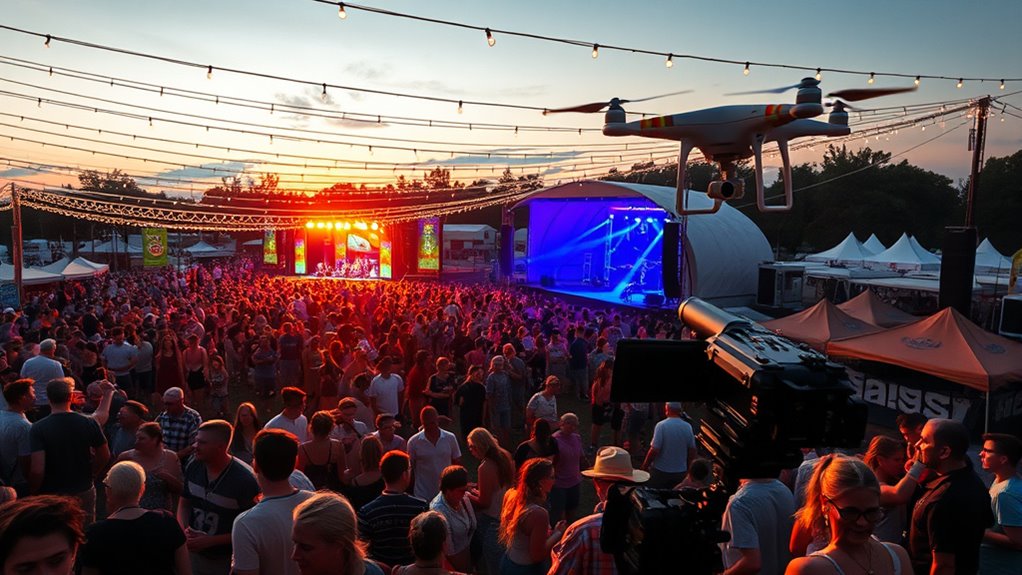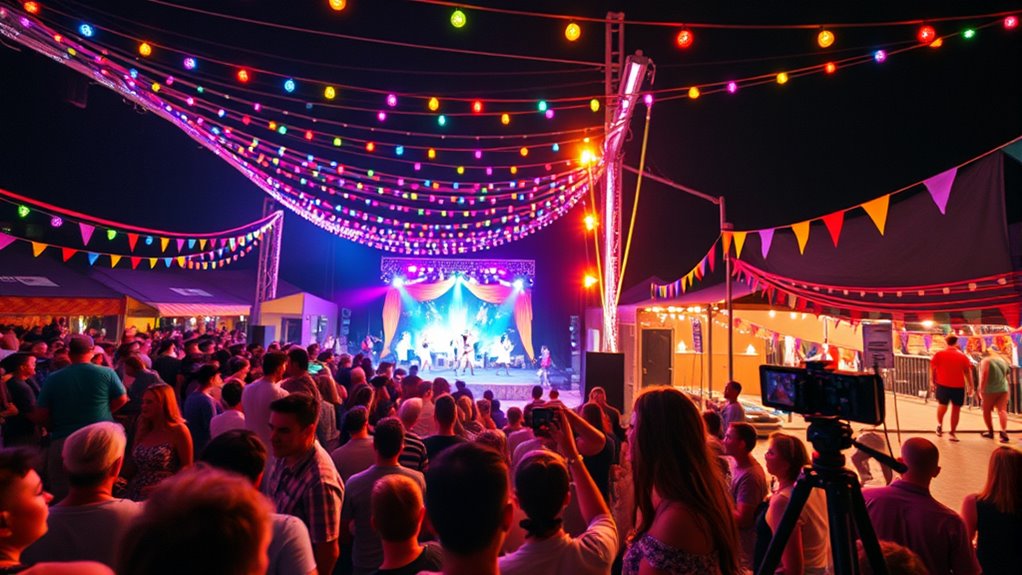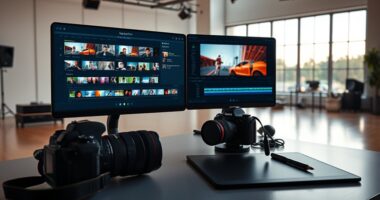To plan a festival aftermovie from first shot to final cut, start with a clear budget that guides your equipment and crew choices. Scout locations beforehand to identify key spots and lighting conditions. Create a shot list with diverse footage ideas like wide-angle and candid shots, focusing on capturing the festival’s energy. Coordinate your logistics for smooth filming, and keep post-production in mind. Continue exploring the step-by-step process to ensure your footage tells a vibrant, cohesive story.
Key Takeaways
- Establish a realistic budget to determine equipment, crew, and post-production scope.
- Scout locations beforehand to identify key spots, lighting, and permissions needed.
- Develop a detailed shot list focusing on dynamic angles, crowd energy, and storytelling.
- Plan logistics for equipment setup, movement, and event flow to ensure comprehensive coverage.
- Organize post-production workflows early to facilitate smooth editing and a compelling final cut.

Creating a compelling festival aftermovie starts long before the event ends. In fact, your planning phase is vital for ensuring that your footage captures the energy and essence of the festival. One of the first steps is understanding your budget considerations. Knowing how much money you can allocate helps determine the scope of your filming, the equipment you can afford, and whether you’ll hire professional videographers or rely on a smaller crew. Budget planning also influences your post-production options, so keep it realistic but flexible. Once you have a clear financial framework, you can start focusing on location scouting. This involves visiting the festival site beforehand, noting the best vantage points, lighting conditions, and areas where crowds gather. Proper location scouting ensures you won’t waste precious footage opportunities during the event. It also helps you identify spots that will make your aftermovie visually engaging and dynamic.
Thorough planning and location scouting are essential for capturing a vibrant, engaging festival aftermovie.
When scouting locations, think about how different areas will look on camera and consider the flow of the event. Are there scenic backdrops, stages, or unique installations that will add flavor to your footage? Will you need special permits or permissions to shoot in certain spots? Planning ahead means you can coordinate with event organizers and avoid last-minute surprises. It’s also useful to think about logistics—where you’ll set up your equipment, how you’ll move between locations, and where you’ll position yourself to capture the most compelling moments. Additionally, considering aesthetic enhancements like natural lighting and interesting angles can significantly improve your footage quality.
As you prepare, consider the types of shots you want to get: wide-angle shots of the crowd, close-ups of performers, candid moments of attendees, or aerial footage if you have access to a drone. Having a clear shot list aligned with your location choices will streamline your filming on the day of the event. Remember, the goal is to tell a story that encapsulates the festival experience, so framing your shots with this in mind helps you stay focused.
In essence, your success in creating a enthralling festival aftermovie hinges on thoughtful preparation. Budget considerations keep your project feasible, while thorough location scouting ensures you’re ready to capture the festival’s vibrant atmosphere. Taking these steps early on sets a solid foundation for the entire filming process, making the task of editing and finalizing your aftermovie much smoother and more effective.
Frequently Asked Questions
What Equipment Is Essential for Filming a Festival?
You’ll need a reliable camera with good resolution and battery life, along with accessories for camera stabilization like gimbals or steadicams to keep shots smooth. Don’t forget quality audio recording equipment, such as external mics, to capture clear sound amidst the noise. Extra batteries, memory cards, and weather protection gear are essential to guarantee you’re ready for the dynamic festival environment and can capture every moment seamlessly.
How Do I Manage a Large Filming Team Effectively?
You manage a large filming team effectively by prioritizing team coordination and applying strong leadership strategies. Clearly assign roles, set expectations, and communicate regularly to guarantee everyone knows their responsibilities. Use tools like walkie-talkies or messaging apps for real-time updates. Lead by example, stay organized, and motivate your team. Flexibility and active oversight help you adapt to changing festival dynamics, ensuring smooth collaboration from start to finish.
What Are the Best Editing Software Options for Aftermovies?
Imagine you’re a modern filmmaker but still love the nostalgia of film. For editing your aftermovie, Adobe Premiere Pro and DaVinci Resolve are top choices. They offer robust tools for color grading and sound design, helping your footage pop and sound immersive. Premiere Pro’s user-friendly interface suits beginners, while Resolve excels in color correction. Both support quick editing workflows, ensuring your festival memories look stunning and professionally polished.
How Can I Ensure Legal Compliance When Filming at Festivals?
To guarantee legal compliance when filming at festivals, you need to obtain the necessary permits and licenses beforehand. Always secure permissions from festival organizers and relevant authorities. Additionally, get copyright clearance for any music or footage you plan to use. Respect performers’ rights and avoid filming restricted areas. Staying proactive with permits and licensing helps you avoid legal issues and creates a smooth, professional production process.
What Are Creative Ideas to Make My Aftermovie Stand Out?
Imagine your aftermovie is a canvas; use unique angles and innovative techniques like drone shots or slow-motion to make it pop. I once saw a filmmaker capture a crowd’s energy from above, transforming ordinary footage into a mesmerizing story. To stand out, combine dynamic camera work with creative editing, vibrant color grading, and immersive sound design. These elements will give your video a fresh, memorable vibe that truly captures the festival’s spirit.
Conclusion
Now that you know each step, your festival aftermovie will be more than just footage—it’s a story waiting to be told. With careful planning, creative shots, and editing flair, you’ll craft a visual masterpiece that captures the soul of the event. Remember, every great film starts with a single shot; your journey from first frame to final cut is where magic happens. So go ahead, turn your festival memories into a timeless story—because this is your moment to shine.










